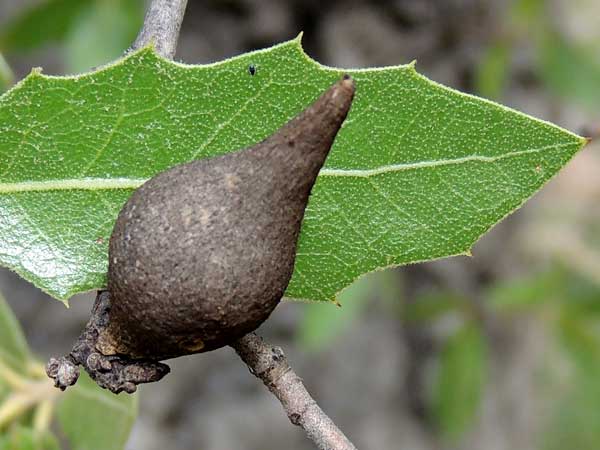Oak Stem Gall
Heteroecus ?

Observed in the riparian corridor of Florida Canyon, Sta. Rita Mts., Arizona, USA. 27 July 2013. Host tree is Quercus emoryi. This gall is more than a year old having been a result of the prior year's wasp activity and now no wasps or their larvae would be found inside. There is an exit hole on the lower right side.
Sponsored Links:
First off, gall wasps do not sting. In deed they are so delicate and small you would be troubled to actually notice one in flight from more than a few tens of centimeters away. Oak trees almost always have one or many gall wasp species in association.
From Wikipedia: The reproduction of the gall wasp is partly pure two-sex propagation, and partly pure parthenogenesis, in which a male is completely unnecessary. With most species, however, an alternation of generations occurs, with one two-sex generation and one parthenogenic generation annually. This process differentiates the various generations primarily in their appearance and the form of the plant galls they induce. The larvae of most gall wasps develop in characteristic plant galls they induce themselves, but many species are also inquilines of other gall wasps, such as those of the genus Synergus. The plant galls mostly develop directly after the female insect lays the eggs. The inducement for the gall formation is largely unknown; discussion speculates as to chemical, mechanical, and viral triggers. The hatching larvae nourish themselves with the nutritive tissue of the galls, in which they are otherwise well-protected from external environmental effects. The host plants and the size and shape of the galls are specific to the majority of gall wasps, whereas about 70% of the known species live in various types of oak trees. One can find galls on nearly all parts of such trees, some on the leaves, the buds, the branches, and the roots. Other species of gall wasps live in eucalyptus trees, rose bushes or maple trees, as well as many herbs. Frequently, the determination of the species is much easier through observation of the galls produced rather than the insect itself.
Cynipidae -- Gall Wasp Family
More Information:
- Wikipedia
- Bugguide Iowa State University
- Encyclopedia of Life
- Google Images
- Google Scholar Literature Search